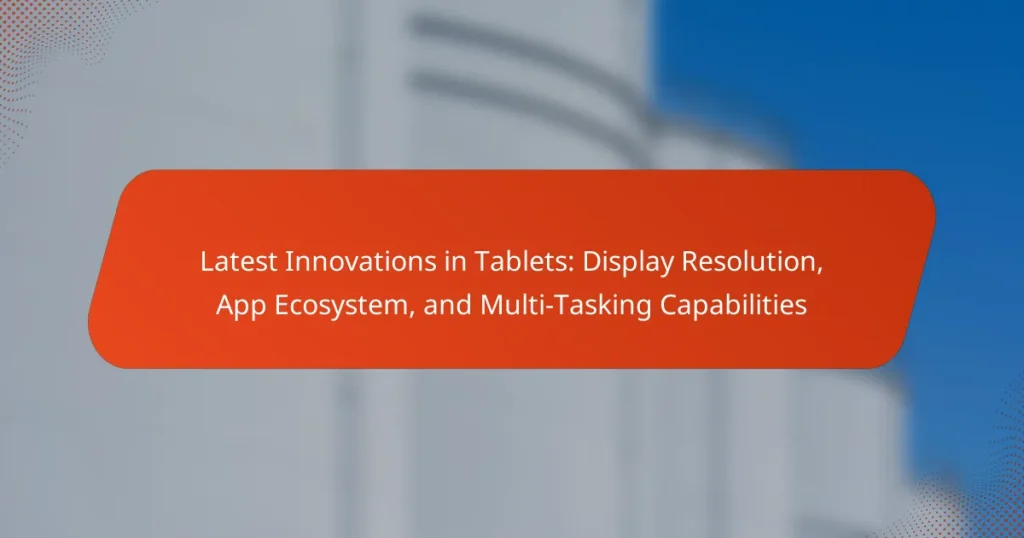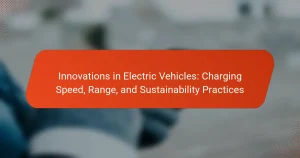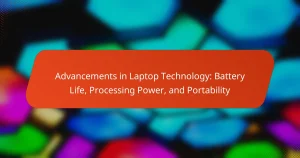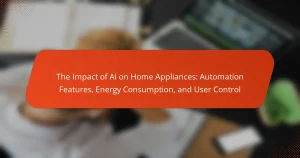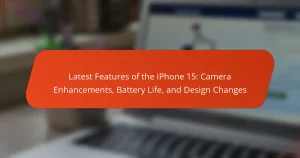The article focuses on the latest innovations in tablets, highlighting advancements in display resolution, app ecosystems, and multi-tasking capabilities. Recent developments include high-resolution displays with refresh rates of up to 120Hz and the integration of OLED technology for improved visual quality. The app ecosystem has expanded, offering a wider range of productivity and creative applications, while enhanced multi-tasking features allow users to run multiple apps simultaneously with split-screen functionality. Additionally, some tablets now support external displays for a desktop-like experience, and enhanced processing power contributes to faster performance and superior graphics. These innovations cater to both casual users and professionals seeking versatile devices.
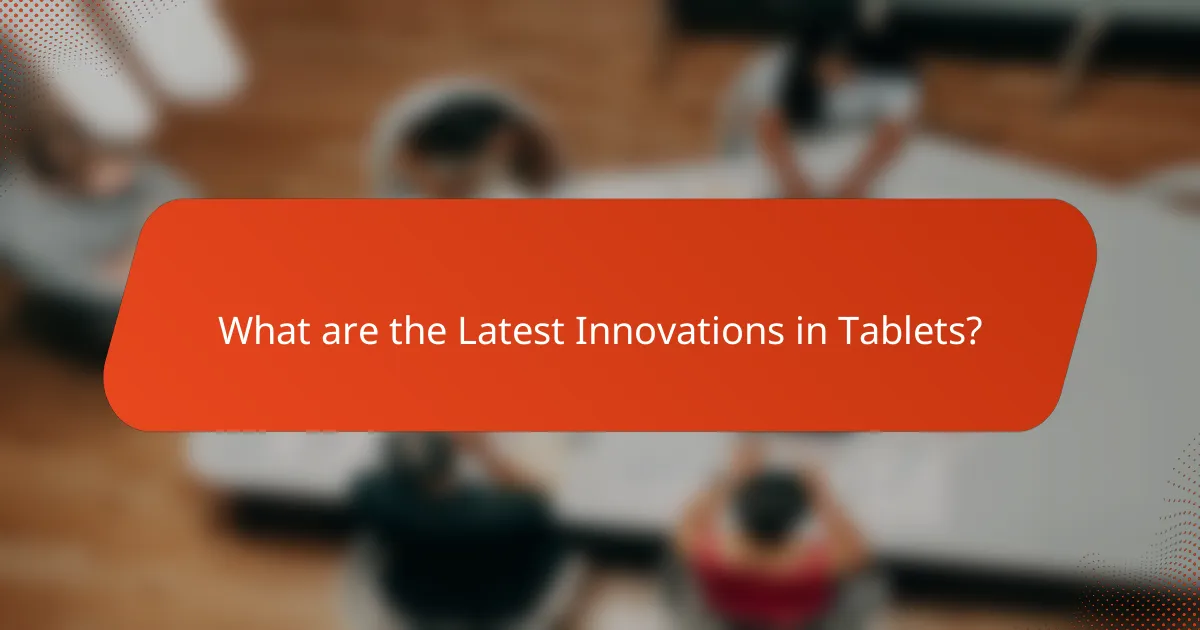
What are the Latest Innovations in Tablets?
Latest innovations in tablets include advancements in display resolution, enhanced app ecosystems, and improved multi-tasking capabilities. High-resolution displays now reach up to 120Hz refresh rates for smoother visuals. Tablets are incorporating OLED technology for deeper blacks and vibrant colors. The app ecosystem has expanded significantly, with more productivity and creative applications available. Multi-tasking features allow users to run multiple apps simultaneously with split-screen functionality. Some tablets now support external displays for a desktop-like experience. Enhanced processing power enables faster performance and better graphics. These innovations cater to both casual users and professionals seeking versatile devices.
How have display resolutions evolved in recent tablet models?
Recent tablet models have seen significant advancements in display resolutions. Many new tablets now feature resolutions exceeding 2000 x 1200 pixels. High-end models, like the Apple iPad Pro, offer resolutions up to 2732 x 2048 pixels. This evolution enhances visual clarity and detail for users. Additionally, the introduction of OLED and mini-LED technologies has improved color accuracy and contrast. Many manufacturers have adopted higher pixel densities, leading to sharper images. The trend towards 4K displays is also emerging in premium tablets. These advancements cater to gamers, designers, and media consumers seeking superior visual experiences.
What are the current trends in tablet display technology?
Current trends in tablet display technology include increased adoption of OLED and Mini-LED displays. These technologies offer better color accuracy and contrast compared to traditional LCDs. Additionally, higher refresh rates, such as 120Hz, are becoming standard for smoother scrolling and improved responsiveness. Manufacturers are also focusing on thinner bezels to maximize screen real estate. Furthermore, advancements in resolution, with many tablets now featuring 4K displays, enhance visual clarity. Touchscreen sensitivity is improving, allowing for more precise input. Finally, foldable display technology is emerging, offering innovative form factors and versatility.
How does display resolution impact user experience on tablets?
Display resolution significantly impacts user experience on tablets. Higher resolution provides clearer images and sharper text. This clarity enhances reading, gaming, and video streaming experiences. Users can discern fine details, improving overall satisfaction. According to a study by DisplayMate, higher resolution screens can lead to better color accuracy and contrast. This results in more vibrant visuals. Additionally, higher resolutions allow for better multitasking capabilities. Users can view multiple apps simultaneously without losing clarity. Thus, display resolution plays a crucial role in defining the quality of tablet usage.
What advancements have been made in the app ecosystem for tablets?
Recent advancements in the app ecosystem for tablets include improved compatibility and performance enhancements. Developers have optimized applications specifically for tablet interfaces. This has resulted in better user experiences and increased functionality. Enhanced multitasking features allow users to run multiple apps simultaneously. Split-screen and picture-in-picture modes have become standard in many operating systems. Additionally, cloud integration has streamlined app processes and data sharing. The introduction of app stores with curated selections has simplified app discovery. These advancements collectively contribute to a more robust and versatile tablet app ecosystem.
How do app availability and compatibility vary across different tablet brands?
App availability and compatibility differ significantly among tablet brands. Major brands like Apple, Samsung, and Amazon offer distinct app ecosystems. Apple’s iOS supports a wide range of high-quality apps optimized for iPads. Samsung tablets, running on Android, have access to Google Play Store, which hosts a diverse selection of apps. Amazon’s Fire tablets use a modified version of Android, limiting access to some apps available on standard Android devices. Compatibility issues may arise due to varying operating systems and hardware specifications. Additionally, some apps are developed exclusively for certain brands, impacting availability. For example, many productivity apps are tailored for iOS, while others may be Android-specific.
What role do app ecosystems play in enhancing tablet functionality?
App ecosystems significantly enhance tablet functionality by providing a diverse range of applications tailored for various tasks. These ecosystems allow users to customize their devices according to personal and professional needs. For instance, productivity apps enable efficient work management, while creative apps facilitate content creation. The availability of educational apps also supports learning and skill development. Furthermore, app ecosystems foster continuous updates and improvements, ensuring that users benefit from the latest features. Statistics show that tablets with robust app ecosystems see higher user satisfaction and engagement rates. This integration of apps ultimately transforms tablets into versatile tools for everyday use.
What improvements have been made in multi-tasking capabilities of tablets?
Recent improvements in multi-tasking capabilities of tablets include enhanced split-screen functionality. Users can now run two apps simultaneously in a more user-friendly interface. Additionally, many tablets support floating windows, allowing users to access multiple applications at once without losing focus.
Operating systems have also optimized resource management for better performance during multi-tasking. For instance, iPadOS introduced a feature called Slide Over, enabling quick access to secondary apps. Android has similarly improved its picture-in-picture mode, allowing video playback while using other apps.
These advancements lead to increased productivity for users. A study by IDC noted that enhanced multi-tasking features contribute to a 30% increase in user efficiency. Overall, these innovations provide a more seamless and effective multitasking experience on tablets.
How can users effectively utilize multi-tasking features on modern tablets?
Users can effectively utilize multi-tasking features on modern tablets by employing split-screen mode and picture-in-picture functionality. Split-screen mode allows users to run two applications simultaneously, enhancing productivity. Users can easily access their email while browsing the web or watching videos. To activate this feature, users typically swipe from the edge of the screen or use the app switcher.
Picture-in-picture functionality lets users watch videos while using other apps. This feature is particularly useful for multitasking during video calls or streaming. Users can resize and move the video window to their preference.
Additionally, users should familiarize themselves with gestures and shortcuts specific to their tablet’s operating system. For example, some tablets allow users to quickly switch between apps with a simple swipe. Understanding these features can significantly enhance the multi-tasking experience.
Overall, leveraging these capabilities can lead to more efficient use of time and resources on modern tablets.
What are the limitations of multi-tasking on tablets compared to traditional computers?
Tablets have significant limitations in multi-tasking compared to traditional computers. Tablets often lack the processing power of traditional computers. This results in slower performance when running multiple applications simultaneously. Additionally, tablet operating systems may restrict the number of apps that can run in the background. This limitation can hinder productivity for users who require multiple applications open at once.
Furthermore, tablet screen sizes are generally smaller than those of traditional computers. This restricts the ability to view multiple apps side by side effectively. The user interface on tablets is often designed for single-app usage, making switching between apps less efficient.
Finally, traditional computers typically offer more robust software options for multi-tasking. Many professional applications are optimized for desktop environments, which enhances their functionality in multi-tasking scenarios. These factors collectively contribute to the limitations of multi-tasking on tablets compared to traditional computers.
How do display resolution, app ecosystem, and multi-tasking interconnect?
Display resolution, app ecosystem, and multi-tasking are interconnected through user experience and device performance. High display resolution enhances visual clarity, making it easier to view multiple apps simultaneously. A rich app ecosystem supports diverse applications that can leverage high-resolution displays for better functionality. Multi-tasking capabilities allow users to run several applications at once, which is facilitated by a robust app ecosystem. Together, these elements create a seamless experience where high-resolution displays improve the usability of various apps. This integration is essential for modern tablets, as it significantly impacts user satisfaction and productivity.
What are the implications of these innovations for tablet users?
Innovations in tablet technology significantly enhance user experience. Improved display resolution offers sharper images and better color accuracy. This leads to more immersive media consumption and improved productivity. An expanded app ecosystem provides users with a wider range of applications. This enables more tailored experiences for various tasks, from gaming to professional work. Enhanced multi-tasking capabilities allow users to run multiple applications simultaneously. This increases efficiency and improves workflow for users who require multitasking. Overall, these innovations create a more versatile and user-friendly tablet experience.
What tips can enhance the use of innovative features in tablets?
To enhance the use of innovative features in tablets, users should regularly update their operating system. Updates often include new functionalities and improved performance. Users should also explore the settings to customize features according to their preferences. This can maximize both usability and efficiency. Utilizing productivity apps can leverage multi-tasking capabilities effectively. For example, split-screen functionality allows users to work on two apps simultaneously. Additionally, using a stylus can enhance precision in tasks like drawing or note-taking. Lastly, taking advantage of cloud storage can facilitate easy access to files across devices. These practices collectively improve the tablet experience and utilize its innovative features fully.
The main entity of the article is the latest innovations in tablets, focusing on display resolution, app ecosystem, and multi-tasking capabilities. The article outlines advancements such as high-resolution displays with OLED technology, an expanded app ecosystem with enhanced compatibility and performance, and improved multi-tasking features like split-screen functionality. It discusses how these innovations impact user experience, productivity, and overall device performance, while also highlighting the interconnections between display resolution, app availability, and multi-tasking efficiency. Additionally, the article offers practical tips for users to maximize the benefits of these innovative features.
